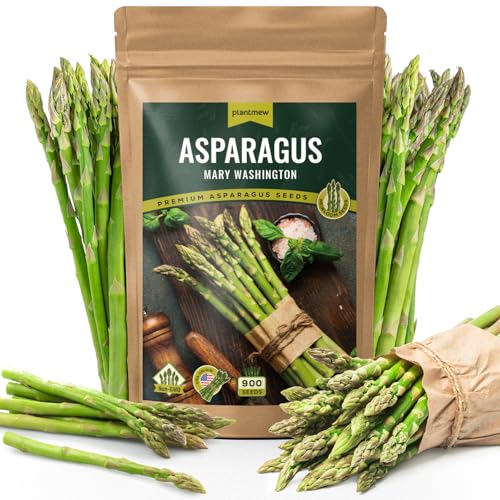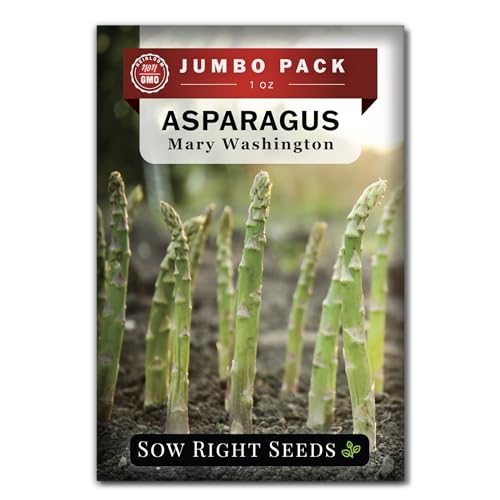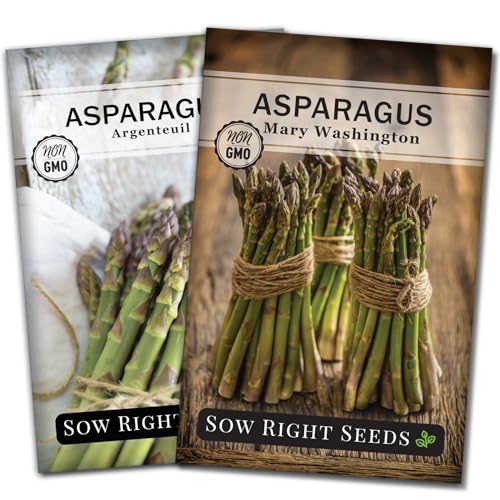Introduction
Asparagus (Asparagus officinalis) stands apart from typical vegetable crops as a true long-term investment in your garden or farm. This perennial vegetable can produce tender, flavorful spears for 15-25 years from a single planting, making it one of the most rewarding crops for patient growers.
While asparagus requires initial commitment and patience—you won’t harvest meaningful yields for 2-3 years—the payoff is substantial. Once established, these hardy plants deliver spring harvests year after year with minimal maintenance, commanding premium prices at farmers’ markets and appealing to health-conscious consumers seeking nutrient-dense vegetables.
Whether you’re a home gardener planning for the future, a market farmer diversifying into high-value crops, or a commercial grower exploring perennial vegetable opportunities, this comprehensive guide provides everything you need to successfully grow asparagus from planting through decades of productive harvests.
Why Invest in Growing Asparagus?
Before committing to asparagus cultivation, understanding its unique advantages helps determine if this crop fits your agricultural goals.
Decades of Production from One Planting
Unlike annual vegetables requiring yearly replanting, asparagus crowns establish extensive root systems that produce for 15-25 years. Some well-maintained asparagus beds have remained productive for over 30 years, delivering remarkable return on initial investment.
This longevity means:
- Reduced annual labor costs after establishment
- No yearly tillage or replanting expenses
- Accumulated knowledge improving management over time
- Consistent spring income for decades
Premium Market Value
Asparagus commands some of the highest prices in the produce section, particularly for locally-grown, fresh-cut spears.
Market Pricing:
- Farmers’ market retail: $6-12 per pound
- Wholesale to restaurants: $4-8 per pound
- Grocery store pricing: $3-6 per pound (growers receive 40-60%)
- Organic certification adds 20-30% premium
Fresh local asparagus sells for significantly more than imported alternatives, and consumer willingness to pay premium prices for quality remains strong.
Low Maintenance After Establishment
Following the initial 2-3 years of patience and care, asparagus becomes one of the lowest-maintenance crops in agriculture. Annual tasks include:
- Spring fertilization
- Weed control (mulching reduces this significantly)
- Post-harvest foliage management
- Winter cleanup
No trellising, pruning, or intensive pest management required.
Nutritional Powerhouse
Asparagus offers impressive nutritional benefits that appeal to health-conscious consumers:
- High in fiber (2.8g per cup)
- Excellent source of folate (vitamin B9)
- Rich in vitamins A, C, E, and K
- Contains antioxidants including glutathione
- Low in calories (27 per cup)
- Good source of iron and potassium
These health benefits support premium pricing and strong market demand.
Climate Adaptability
Asparagus thrives across a wide temperature range, succeeding in USDA hardiness zones 3-8, with some varieties adapted to zone 9. This broad adaptability makes asparagus viable across most of the continental United States.
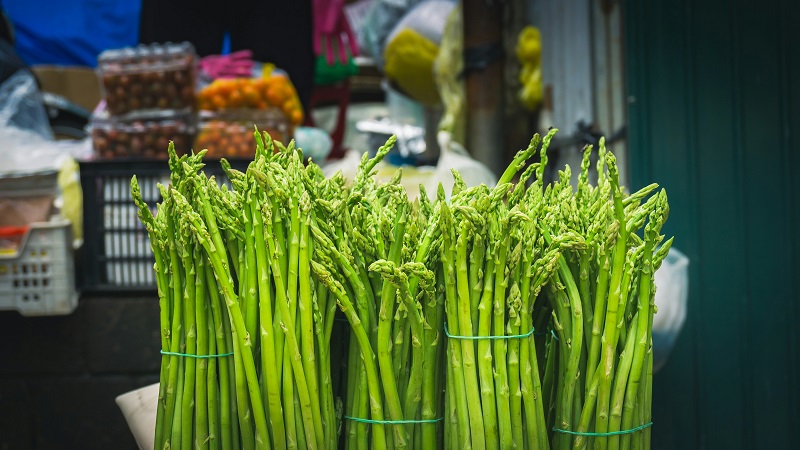
Understanding Asparagus: The Basics
Asparagus is a perennial vegetable where the edible portion consists of young shoots (spears) that emerge from underground crowns each spring. Understanding the plant’s lifecycle is essential for successful cultivation.
The Asparagus Lifecycle
Year 1-2 (Establishment): Plants focus energy on developing extensive root systems (crowns) that can extend 5-6 feet wide and 10-15 feet deep. No harvesting occurs during this critical period.
Year 3 (First Harvest): Light harvesting begins, typically 2-4 weeks of cutting to avoid stressing young plants.
Year 4+ (Full Production): Beds reach full productivity with 6-8 week harvest seasons producing 0.5-1 pound of spears per crown annually.
Male vs. Female Plants
Asparagus plants are dioecious (separate male and female plants), an important consideration for production:
Male Plants:
- Produce more spears (25-30% higher yield)
- Larger, more uniform spears
- Longer productive life
- No energy diverted to seed production
Female Plants:
- Produce red berries containing seeds
- Lower spear production
- Self-seeding can create weed problems
- Shorter productive life
Modern Varieties: Most contemporary asparagus varieties are all-male hybrids, eliminating female plants’ disadvantages and maximizing production efficiency.
Ideal Growing Conditions for Asparagus
Success with asparagus begins with matching the crop to appropriate site conditions.
Climate Requirements
Asparagus performs best in regions with distinct seasons, particularly cold winters that induce dormancy.
Optimal Conditions:
- Cold winter temperatures (below 50°F for 8-12 weeks)
- Moderate summer temperatures (75-85°F)
- USDA hardiness zones 3-8 (ideal: zones 4-7)
Why Cold Matters: Asparagus requires winter chilling hours (temperatures below 50°F) to break dormancy and trigger vigorous spring growth. Without adequate chilling, spear production decreases significantly.
Regional Adaptations:
- Northern regions (zones 3-5): Excellent asparagus climate; select cold-hardy varieties like ‘Jersey Knight’ or ‘Purple Passion’
- Mid-Atlantic and Midwest (zones 5-7): Ideal conditions for all varieties
- Southern regions (zones 8-9): Choose low-chill varieties like ‘UC 157’; production may be less vigorous
- Southwest: Possible with careful site selection and variety choice; avoid hottest microclimates
Soil Requirements
Asparagus is particular about soil conditions, requiring well-drained, fertile ground for optimal production.
Soil Characteristics:
- Texture: Sandy loam to loamy soil; avoid heavy clay
- Drainage: Essential—asparagus crowns rot in waterlogged conditions
- Depth: Deep soil (2+ feet) without hardpan layers
- Organic matter: High levels (4-6%) support productivity
- pH: 6.5-7.5 (slightly acidic to neutral)
Drainage Testing: Dig a hole 12 inches deep, fill with water, and observe drainage. If water remains after 6-8 hours, drainage is inadequate. Consider raised beds or select a different site.
pH Management: Test soil pH before planting. If below 6.0, apply agricultural lime 2-3 months before planting. If above 7.5, incorporate sulfur to lower pH.
Sunlight Needs
Full sun exposure is critical for vigorous spear production.
Requirements:
- Minimum 8 hours direct sunlight daily
- Southern exposure provides optimal light
- Avoid shaded locations or areas under trees
- More sun = more spears and higher quality
Inadequate light results in thin, weak spears and reduced yields.
Site Selection Considerations
Choose locations with:
- Full sun exposure throughout the day
- Excellent drainage
- Protection from strong winds (tall ferns can lodge)
- Distance from competing tree roots
- Long-term permanence (20+ year commitment)
Avoid:
- Low-lying areas where cold air settles
- Sites with perennial weed problems (especially quackgrass)
- Compacted or heavy clay soils
- Areas requiring future development
Soil Preparation: Foundation for Success
Thorough soil preparation is the most important step in establishing productive asparagus beds. The effort invested now determines productivity for decades.
Timing
Prepare beds in fall for spring planting, allowing amendments to incorporate and settle over winter.
Step-by-Step Soil Preparation
1. Weed Elimination: Remove all perennial weeds before planting—they’re difficult to control once asparagus is established.
- For severe weed problems, consider a full growing season of weed suppression before planting
- Smother weeds with black plastic or multiple tilling passes
- Herbicide option: glyphosate application months before planting (follow label instructions)
2. Deep Tillage: Till or plow soil to 12-18 inch depth, breaking up compaction and incorporating amendments.
3. Organic Matter Incorporation: Add substantial amounts of organic material:
- Well-composted manure: 3-4 inches (avoid fresh manure)
- Finished compost: 2-3 inches
- Aged leaf mold or mushroom compost: 2-3 inches
Organic matter improves:
- Soil structure and drainage
- Water retention in sandy soils
- Nutrient availability
- Beneficial soil biology
4. pH Adjustment: Based on soil test results:
- For acidic soils (pH < 6.5): Apply agricultural lime at recommended rates (typically 50-100 lbs per 1,000 sq ft)
- For alkaline soils (pH > 7.5): Incorporate elemental sulfur (rates vary by pH and soil type)
5. Fertility Enhancement: Apply a complete fertilizer before planting:
- Balanced fertilizer (10-10-10): 20-30 lbs per 1,000 sq ft
- OR organic option: rock phosphate (bone meal) and greensand, following package directions
6. Final Grading: Level and smooth the bed, creating slight crowns to ensure drainage.
Pro Tip: Send soil samples to your local cooperative extension for comprehensive analysis including pH, nutrients, and organic matter content. This $15-30 investment prevents costly mistakes.
Planting Asparagus: Seeds vs. Crowns
Two planting methods exist for asparagus, each with distinct advantages and timelines.
Starting from Seed
Advantages:
- Most economical option (seeds cost $3-8 per packet)
- Wider variety selection
- Interesting for hobby growers
Disadvantages:
- Adds 1 year to production timeline
- More labor intensive
- Lower germination rates (60-80%)
- Not recommended for commercial operations
Seed Starting Process:
- Start seeds indoors 12-14 weeks before last frost
- Soak seeds 24-48 hours before planting
- Plant ½ inch deep in seed starting mix
- Maintain 70-80°F for germination (14-21 days)
- Transplant to garden when 12 inches tall after hardening off
Planting Crowns (Recommended Method)
Crowns are 1-year-old asparagus roots purchased from nurseries or specialty suppliers, the standard method for both home and commercial production.
Advantages:
- Saves 1 year of growing time
- More reliable establishment
- Industry standard for commercial production
- Immediate root development
Disadvantages:
- Higher initial cost ($15-40 per 25 crowns)
- Must plant soon after receiving
- Limited to available varieties
Crown Selection:
- Purchase from reputable suppliers (Jersey Asparagus Farms, Nourse Farms, etc.)
- Choose 1-year-old crowns (not 2-year; they don’t establish better)
- Look for thick, fleshy roots with multiple buds
- All-male hybrid varieties recommended
- Order 10-15 crowns per family member for home gardens
Planting Instructions for Crowns
Timing: Plant crowns in early spring when soil temperatures reach 50°F, typically March-May depending on location.
Trench Method (Traditional):
- Dig trenches: 8-10 inches deep and 12-18 inches wide
- Spacing:
- Between plants in row: 12-18 inches (home gardens: 18 inches; commercial: 12 inches)
- Between rows: 4-5 feet
- Create mounds: Build 2-inch mounds at the bottom of trenches at appropriate spacing
- Place crowns: Set crowns on mounds, spreading roots outward like an octopus
- Cover: Add 2-3 inches of soil over crowns
- Gradual filling: As shoots emerge and grow 6-8 inches, add more soil until trench is level
Alternative: Raised Bed Method
For poorly-drained sites, plant crowns in raised beds 8-12 inches high, placing crowns 4-6 inches below the surface.
Planting Density:
- Home gardens: 25-30 crowns per 100 sq ft
- Commercial production: 40-50 crowns per 100 sq ft
Image Suggestion 4: Step-by-step diagram showing crown planting in trenches
Alt Text: “Illustration showing proper asparagus crown planting technique in prepared trenches with spacing measurements”
Irrigation and Early Care
Proper water management during establishment determines long-term productivity.
First Year Irrigation
Consistent moisture is critical for root development without waterlogging.
Watering Guidelines:
- Provide 1-1.5 inches of water weekly (rainfall + irrigation)
- Water deeply 2-3 times per week rather than daily shallow watering
- Maintain consistent moisture without saturation
- Reduce watering as fall approaches to encourage dormancy
Irrigation Methods:
- Drip irrigation: Most efficient, delivers water to root zone while keeping foliage dry
- Soaker hoses: Good alternative for home gardens
- Furrow irrigation: Suitable for commercial operations with proper grading
- Overhead sprinklers: Least desirable; wet foliage increases disease risk
Mulching Benefits: Apply 2-4 inches of organic mulch after shoots emerge:
- Conserves moisture
- Suppresses weeds
- Moderates soil temperature
- Adds organic matter as it decomposes
Best mulch materials: Straw, aged wood chips, shredded leaves, or pine needles
Weed Management
Weed competition seriously reduces establishment success. Asparagus can’t compete with aggressive weeds during early growth.
Control Strategies:
- Hand-pull weeds when small
- Mulch heavily (4-6 inches)
- Shallow cultivation (avoid damaging crowns)
- Pre-emergent herbicides labeled for asparagus (commercial operations)
Critical Period: First 2-3 years require vigilant weed control; mature beds become more competitive.
Fertilization
Year 1: If soil was properly prepared, supplemental fertilization isn’t necessary during establishment year. Excess nitrogen can actually reduce crown development.
Year 2+: Apply fertilizer in early spring before spear emergence:
- 10-10-10 fertilizer: 1-2 lbs per 100 sq ft
- OR compost: 1-2 inches
- Side-dress with additional nitrogen after harvest ends
Harvest Management: Patience and Timing
Understanding when and how to harvest asparagus is crucial for maintaining plant health and maximizing long-term productivity.
The Establishment Period: Years 1-2
Do NOT harvest during the first two growing seasons. This cannot be overstated—premature harvesting weakens crowns and reduces future productivity.
Why waiting matters:
- Crowns need time to develop extensive root systems
- Energy from photosynthesis builds storage reserves
- Premature harvesting can kill young crowns
- Patient growers are rewarded with decades of production
During establishment:
- Allow ferns to grow fully
- Maintain watering and weed control
- Let foliage yellow naturally in fall before cutting
- Mark rows to prevent accidental damage
Year 3: First Harvest
Begin light harvesting the third spring, limiting duration to avoid stressing plants.
Guidelines:
- Harvest for only 2-4 weeks
- Stop when spear diameter decreases noticeably
- Allow remaining spears to develop into ferns
- This builds crowns for future productivity
Year 4+: Full Production
From the fourth year onward, beds reach full productivity.
Harvest Season:
- Duration: 6-8 weeks (can extend to 10 weeks in mature beds)
- Timing: Early spring through late May/early June
- Frequency: Daily during peak production
Harvest Indicators:
- Spear height: 6-10 inches above ground
- Thickness: Pencil-diameter or larger (thinner than pencil = stop harvesting)
- Before tip loosening: Harvest while tips remain tight
Proper Harvesting Technique
Cutting Method (Recommended):
- Use sharp knife or specialized asparagus knife
- Cut spears 1-2 inches below soil surface
- Angle cut to avoid damaging adjacent emerging spears
- Harvest during cool morning hours for best quality
Snapping Method (Alternative):
- Bend spear near soil level until it snaps
- Snap occurs naturally at the tender/tough transition
- Easier for beginners but wastes some tender stem
Harvesting Frequency: During peak season, check beds daily. Asparagus grows rapidly (up to 10 inches in 24 hours in warm weather), and spears quickly become overmature.
Quality Standards:
- Straight, uniform spears
- Tight tips with no opening
- Fresh green color (or purple for purple varieties)
- 6-10 inch length
- Consistent diameter within harvest
Post-Harvest Handling
Immediate Care:
- Stand spears upright in shallow water
- Refrigerate promptly (asparagus loses quality rapidly)
- Optimal storage: 32-36°F with high humidity
- Shelf life: 7-10 days when properly handled
For Market Sales:
- Bunch in uniform sizes (typically ½ or 1 pound)
- Trim to consistent lengths
- Band with rubber bands or twist ties
- Display standing in water for freshness appeal
Post-Harvest Care and Fern Management
The period after harvest is crucial for building crown strength for next year’s production.
Allowing Fern Development
After harvest ends, let all remaining spears grow into tall ferns (4-6 feet).
Why ferns matter:
- Photosynthesize throughout summer
- Build carbohydrate reserves in crowns
- Determine next year’s productivity
- Provide nutrients for winter storage
Never cut ferns during the growing season. Each removed fern reduces future production.
Summer Maintenance
Irrigation: Provide 1 inch of water weekly during summer, especially during drought.
Weed Control: Continue managing weeds to reduce competition.
Fertilization: Apply compost or balanced fertilizer after harvest ends:
- 1-2 inches compost OR
- 1-2 lbs 10-10-10 fertilizer per 100 sq ft
Pest Monitoring: Watch for asparagus beetles and other pests (covered in next section).
Fall and Winter Care
Fern Management:
- Allow ferns to yellow naturally in fall (October-November)
- Cut ferns to ground level after they’ve completely died
- Remove and destroy old ferns (don’t compost if disease present)
- Clean beds of debris
Why cut ferns:
- Removes overwintering pest habitat
- Reduces disease carryover
- Improves spring emergence visibility
- Tidies the bed
Late Fall Mulching: In cold climates (zones 3-5), apply 4-6 inches of straw mulch after ground freezes to prevent crown heaving.
Pest and Disease Management
While asparagus is relatively pest-resistant, several issues can affect productivity.
Major Pests
Asparagus Beetle (Crioceris asparagi): Most significant pest, both adults and larvae feed on spears and ferns.
Identification:
- Adult: Metallic blue-black beetle with cream spots and red margins (¼ inch)
- Larvae: Gray-green grubs with black heads
- Eggs: Dark, shiny, attached to ferns
Damage:
- Scarred, blemished spears (reduced market value)
- Defoliated ferns (weakens crowns)
- Can cause significant economic loss
Control:
- Handpick beetles and destroy eggs on small plantings
- Encourage beneficial insects (lady beetles, lacewings)
- Rotenone or pyrethrin sprays (organic options)
- Sevin (carbaryl) for severe infestations (follow label)
- Destroy ferns in fall to eliminate overwintering sites
Common Spotted Asparagus Beetle: Less common relative causing similar damage.
Aphids: Occasionally colonize ferns, rarely causing serious damage.
Control: Insecticidal soap or strong water spray
Common Diseases
Fusarium Crown and Root Rot: Most serious disease, caused by soil-borne fungi.
Symptoms:
- Yellowing, stunted ferns
- Gradual decline in vigor
- Crown rot visible when excavated
- Thin, weak spears
Management:
- Plant disease-resistant varieties (‘Jersey’ series)
- Ensure excellent drainage
- Avoid overwatering
- Remove and destroy infected plants
- Don’t replant asparagus in infected areas
- No effective chemical control
Rust (Puccinia asparagi): Fungal disease appearing as orange-brown pustules on ferns.
Management:
- Plant rust-resistant varieties
- Space plants for good air circulation
- Remove infected ferns in fall
- Fungicides rarely necessary in home gardens
Purple Spot (Stemphylium vesicarium): Fungal disease causing purple-brown lesions on spears and ferns.
Management:
- Avoid overhead irrigation
- Ensure good air circulation
- Remove infected plant material
- Fungicides for severe cases
Maximizing Long-Term Productivity
Strategic management practices extend bed productivity and increase yields.
Annual Fertilization
Consistent fertility maintains vigor and production.
Timing:
- Early spring before spear emergence
- After harvest concludes
Application:
- Broadcast 2-3 inches compost OR
- Apply 10-10-10 fertilizer at 2 lbs per 100 sq ft
- Side-dress with nitrogen (blood meal, 21-0-0) after harvest: 1 lb per 100 sq ft
Mulching Strategy
Maintain 3-4 inches of organic mulch year-round:
- Suppresses weeds (major labor saving)
- Conserves moisture
- Moderates soil temperature
- Adds organic matter continuously
Best materials:
- Straw (avoid hay with weed seeds)
- Aged wood chips
- Shredded leaves
- Pine needles
Bed Renovation
After 15-20 years, productivity naturally declines. Options include:
Full Replacement:
- Remove old crowns
- Prepare soil thoroughly
- Plant new crowns in same or different location
Interplanting:
- Plant new crowns between older plants
- Gradually transition as old plants decline
- Maintains production continuity
Extending Harvest Season
White Asparagus Production: Mound soil 8-10 inches high over crowns in early spring, harvesting spears before they emerge into light. Labor-intensive but commands premium prices ($10-15/lb).
Season Extension: Low tunnels or row covers placed over beds in early spring advance harvest by 1-2 weeks.
Asparagus Varieties: Selecting for Your Region
Modern all-male hybrid varieties significantly outperform older open-pollinated types.
Recommended Varieties
Jersey Knight:
- Industry standard all-male hybrid
- Excellent disease resistance (fusarium, rust)
- High yields of large spears
- Widely adapted (zones 3-8)
- Best overall choice for most growers
Jersey Supreme:
- Improved Jersey variety
- Uniform, high-quality spears
- Excellent disease resistance
- Slightly later emergence (avoids late frosts)
Jersey Giant:
- Large-diameter spears
- Very productive
- Good disease resistance
- Popular commercial variety
Millennium:
- Newer all-male hybrid
- Outstanding disease resistance
- Very uniform spears
- Excellent for Midwest and East
Purple Passion:
- Purple-speared variety (turns green when cooked)
- Sweeter, nuttier flavor
- Novelty appeal for farmers’ markets
- Less productive than green types
- More tender (can eat raw)
UC 157:
- Low-chill variety for warmer climates (zones 7-9)
- California development
- Tolerates heat better than standard varieties
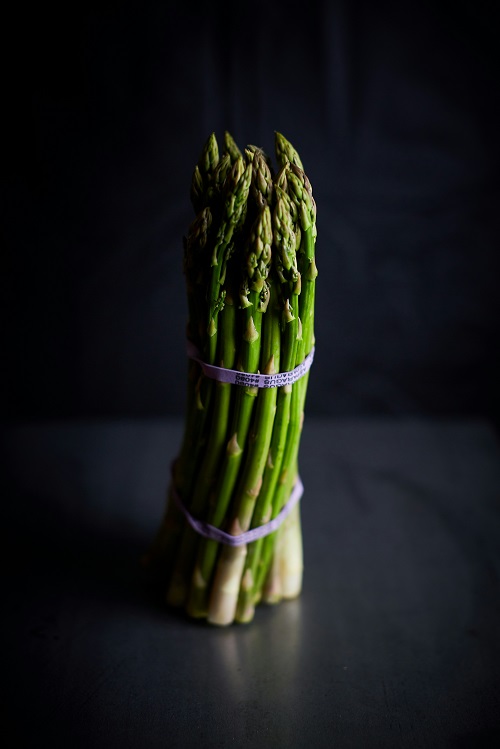
Economics of Asparagus Production
Understanding financial considerations helps determine if asparagus fits your operation.
Startup Costs (1,000 sq ft bed)
Materials:
- Crowns (200-300): $100-200
- Soil amendments: $50-100
- Mulch: $40-80
- Irrigation supplies: $100-200 (drip system)
- Total: $300-600
Annual Operating Costs (Established Bed)
- Fertilizer: $30-50
- Mulch: $30-50
- Irrigation/utilities: $20-40
- Pest control: $10-30
- Labor (harvest, maintenance): Variable
- Total: $100-200/year
Production and Revenue Expectations
Mature Bed (1,000 sq ft):
- Plant population: 200-300 crowns
- Annual yield: 150-300 lbs
- Retail price: $6-10/lb
- Gross revenue: $900-3,000/year
Net profit: $700-2,800/year after operating costs
Per-acre commercial production:
- Yield: 2,000-4,000 lbs
- Wholesale price: $3-5/lb
- Gross revenue: $6,000-20,000
- Net profit: $3,000-12,000 (after all costs including labor)
Return on Investment
With initial setup costs of $500 and annual net profits of $1,500, ROI is achieved in Year 4, with 15-20+ years of subsequent profitable production.
Marketing Fresh Asparagus
Premium pricing requires effective marketing and quality presentation.
Value Propositions
Emphasize:
- Locally grown (harvested within 24 hours)
- Ultra-fresh (significant quality difference vs. shipped)
- Peak-of-season availability
- No chemicals or pesticides (if applicable)
- Personal grower connection
Best Sales Channels
Farmers’ Markets:
- Highest retail prices
- Direct customer relationships
- Immediate feedback
- Weekend commitment required
Restaurants:
- Consistent weekly orders
- Premium pricing for quality
- Requires reliable production
- Payment terms (often 30 days)
CSA (Community Supported Agriculture):
- Guaranteed market
- Early-season highlight item
- Builds member satisfaction
- Limited by short season
On-Farm Sales:
- No travel time
- Flexible hours
- Limited customer base (requires traffic)
Presentation Tips
- Bundle in attractive, consistent sizes
- Stand upright in water for display
- Include recipes or preparation tips
- Consider value-added products (pickled asparagus)
- Share growing story and farm connection
Frequently Asked Questions
How long before I can harvest asparagus?
Wait until the third year for light harvesting (2-4 weeks), with full production beginning in year four (6-8 week harvest season).
Why can’t I harvest the first two years?
Young crowns need time to develop extensive root systems. Premature harvesting weakens or kills crowns, eliminating future production.
How do I know when to stop harvesting?
Stop when spear diameter decreases noticeably (pencil-thin or smaller), or after 6-8 weeks of cutting, whichever comes first.
Can I grow asparagus in containers?
Not recommended. Asparagus develops massive root systems requiring deep soil (18+ inches). Container production is impractical for meaningful yields.
Does asparagus need cold winters?
Yes, most varieties require 8-12 weeks below 50°F for dormancy and vigorous spring production. Warmer regions (zones 8-9) need low-chill varieties.
How many crowns should I plant?
For home gardens, plant 10-15 crowns per person for adequate fresh supply during season. Commercial operations plant 15,000-30,000 per acre.
Conclusion: Is Asparagus Right for Your Operation?
Growing asparagus represents a long-term commitment that rewards patient, dedicated growers with decades of productive harvests. This premium vegetable offers compelling advantages: multi-decade production from single planting, high market value, relatively low maintenance after establishment, and strong consumer demand for locally-grown spring produce.
Success requires thoughtful site selection, thorough soil preparation, quality crowns, and most importantly, patience during the 2-3 year establishment period. However, growers willing to make this initial investment are rewarded with one of agriculture’s most enduring crops.
Whether you’re a home gardener planning for future harvests, a market farmer seeking high-value specialty crops, or a commercial grower diversifying operations, asparagus deserves serious consideration. Few crops offer comparable long-term productivity with such modest annual maintenance requirements.
Ready to start your asparagus adventure? Begin by selecting an appropriate site with excellent drainage and full sun. Order quality all-male hybrid crowns from reputable suppliers for spring planting. Prepare soil thoroughly, plant crowns properly, and most importantly, exercise patience during establishment. Your reward will be tender, sweet spears arriving each spring for 20+ years—a truly lasting agricultural legacy.


